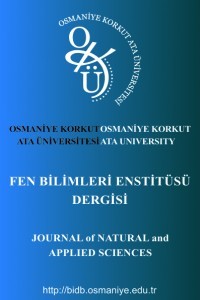Mullit Takviyeli CeO2 Katkılı ZrO2 Seramiklerinin İmalatı ve Karakterizasyonu
Zirkonya, Seryum oksit, Mullit, Karakterizasyon, Aşınma
Fabrication and Characterization of Mullite Reinforced CeO2 Added ZrO2 Ceramics
Zirconia, Cerium oxide, Mullite, Characterization, Wear,
___
- [1] Boyraz T. An investigation on physical and electrical properties of CaO/MgO-stabilized zirconia ceramics formed with different methods. Istanbul Technical University / Graduate School of Natural and Applied Sciences, (Doctoral dissertation). 150p, İstanbul, Turkey, 2008.
- [2] Pekdemir AD. Preparation and characterization of boron carbide at low-temperature from boric acid and polyols. Ankara University / Graduate School of Natural and Applied Sciences, (Doctoral dissertation). 178p, Ankara, Turkey, 2018.
- [3] Ceylan A. The production of functionally graded SiAlON ceramics by tape casting method. Anadolu University / Graduate School of Natural and Applied Sciences, (Doctoral dissertation). 204p, Eskişehir, Turkey, 2006.
- [4] Abi CB. An investigation on fracture toughness of traditional and technical ceramics. Afyon Kocatepe University / Graduate School of Natural and Applied Sciences, (Doctoral dissertation). 194p, Afyon, Turkey, 2009.
- [5] Hafızoğlu MA. Production, characterization and investigation of wear properties of zirconia ceramics with mullite additives and stabilized with different oxides. Sivas Cumhuriyet University / Graduate School of Natural and Applied Sciences, (Doctoral dissertation). 248p, Sivas, Turkey, 2021.
- [6] Hafızoğlu MA., Akkuş A. and Boyraz T. (2021). Fabrication and characterization of mullite reinforced Y2O3 added ZrO2 ceramics. International Conference on Engineering Technologies (ICENTE’21), 18-20 November 2021, 124, Konya, Turkey.
- [7] Hafızoğlu MA., Akkuş A. and Boyraz T. Fabrication and characterization of mullite reinforced CeO2 added ZrO2 ceramics. International Conference on Engineering, Natural and Applied Science (ICENAS’21), 24-26 November 2021, 128, Osmaniye, Turkey.
- [8] Cutler RA., Reynolds JR. and Jones A. Sintering and characterization of polycrystalline monoclinic, tetragonal, and cubic zirconia. Journal of the American Ceramic Society 1992; 75(8); 2173-2183.
- [9] Boyacıoğlu T. Improvement of room temperature mechanical properties of various amount of metal oxide doping cubic zirconia (c-ZrO2) used as electrolyte material for solid oxide fuel cells. Gazi University / Graduate School of Natural and Applied Sciences, (Master's thesis). 123p, Ankara, Turkey, 2007.
- [10] Boyraz T. Dental porcelain powders. Sakarya University / Graduate School of Natural and Applied Sciences, (Master's thesis). 131p, Sakarya, Turkey, 1998.
- [11] Liu PF., Li Z., Xiao P., Luo H. and Jiang TH. Microstructure and mechanical properties of in-situ grown mullite toughened 3Y-TZP zirconia ceramics fabricated by gelcasting. Ceramics International 2018; 44(2); 1394-1403.
- [12] Eichler J., Rödel J., Eisele U. and Hoffman M. Effect of grain size on mechanical properties of submicrometer 3Y‐TZP: fracture strength and hydrothermal degradation. Journal of the American Ceramic Society 2007; 90(9); 2830-2836.
- [13] Sun J., Gao L., Iwasa M., Nakayama T. and Niihara, K. Failure investigation of carbon nanotube/3Y-TZP nanocomposites. Ceramics International 2005; 31(8); 1131-1134.
- [14] El Ouatib R., Guillemet S., Durand B., Samdi A., Rakho LE. and Moussa R. Reactivity of aluminum sulfate and silica in molten alkali-metal sulfates in order to prepare mullite. Journal of the European Ceramic Society 2005; 25(1); 73-80.
- [15] Kucuk I. and Boyraz T. Structural and mechanical characterization of mullite and aluminium titanate reinforced yttria stabilized zirconia ceramic composites. Journal of Ceramic Processing Research 2019; 20(1); 73-79.
- [16] Kumar P., Nath M., Ghosh A. and Tripathi HS. Enhancement of thermal shock resistance of reaction sintered mullite–zirconia composites in the presence of lanthanum oxide. Materials Characterization 2015; 101; 34-39.
- [17] Roy J., Das S. and Maitra S. Solgel‐processed mullite coating—a review. International Journal of Applied Ceramic Technology 2015; 12; E71-E77.
- [18] Denry I. and Kelly JR. State of the art of zirconia for dental applications. Dental materials 2008; 24(3); 299-307.
- [19] Çitak E. and Boyraz T. Microstructural characterization and thermal properties of aluminium titanate/YSZ Ceramics. Acta Physica Polonica A 2014; 125(2); 465-468.
- [20] Önen U. and Boyraz T. Microstructural characterization and thermal properties of aluminium titanate/spinel ceramic matrix composites. Acta Phys. Pol. A 2014; 125(2); 488-490.
- [21] Sacli M., Onen U. and Boyraz T. Microstructural characterization and thermal properties of aluminium titanate/porcelain ceramic matrix composites. Acta Physica Polonica A 2015; 127(4); 1133-1135.
- [22] Boyraz T. and Akkuş A. Investigation of wear properties of mullite and aluminium titanate added porcelain ceramics, Journal of Ceramic Processing Research 2021; 22(2), pp. 226-231.
- [23] Akkus A. and Boyraz T. Investigation of wear properties of CaO, MgO added stabilized zirconia ceramics produced by different pressing methods. Journal of Ceramic Processing Research 2018; 19(3); 249-52.
- [24] Kucuk I., Boyraz T., Gökçe H. and Öveçoğlu ML. Thermomechanical properties of aluminium titanate (Al2TiO5)-reinforced forsterite (Mg2SiO4) ceramic composites. Ceramics International 2018; 44(7); 8277-8282.
- [25] Ming-qing Y., Shi-gang F., Lian-meng Z. and Shu-zhen S. Mechanical properties of ZrO 2 ceramic stabilized by Y 2 O 3 and CeO 2. Journal of Wuhan University of Technology-Materials Science Editorial 2002; 17(2); 14-18.
- ISSN: 2687-3729
- Yayın Aralığı: Yılda 3 Sayı
- Başlangıç: 2018
- Yayıncı: Osmaniye Korkut Ata Üniversitesi
Torpido Benzeri Geometrilerin İki Tandem Düzenlemesi İçin Akış Yapılarının İncelenmesi
Ezgi AKBUDAK, Bülent YANIKTEPE, Ertuğrul ŞEKEROĞLU, Ömer KENAN, Muammer OZGOREN
İstifleme Sırasının Kompozit Katmanlı Basınçlı Kaplarının Yapısal Performansına Etkileri
Ayşe Rüveyda UĞUR, Habibe ÖVET
Mullit Takviyeli CeO2 Katkılı ZrO2 Seramiklerinin İmalatı ve Karakterizasyonu
Mehmet Akif HAFIZOĞLU, Ahmet AKKUŞ, Tahsin BOYRAZ
Türkiye'nin Farklı Bölgelerdeki Güneş Enerjisi Potansiyelinin Analizi
Sıcak Dövme Kalıp ve İş Parçasının Tasarımının Performansı Üzerine Bir Araştırma
Ece Destina BEKLETENLER, Simge İRİZALP, Murat DELİBALCI
Tek Kademeli Absorbsiyonlu Soğutma Sisteminin Farklı Çalışma Sıcaklıklarındaki Performans Analizi
Ali Burak YAVUZ, Osman KARA, Bülent YANIKTEPE
Akışkanlaştırıcı Katkı Oranının Betonların Aşınma Direnci Üzerine Etkisinin Araştırılması
Behcet DÜNDAR, Emriye ÇINAR, Cebrail KAPLAN
Hidrojen Üretimi İçin Geçiş Metali İhtiva Eden Elektrokatalizörlerin Elektrokimyasal Üretimi
